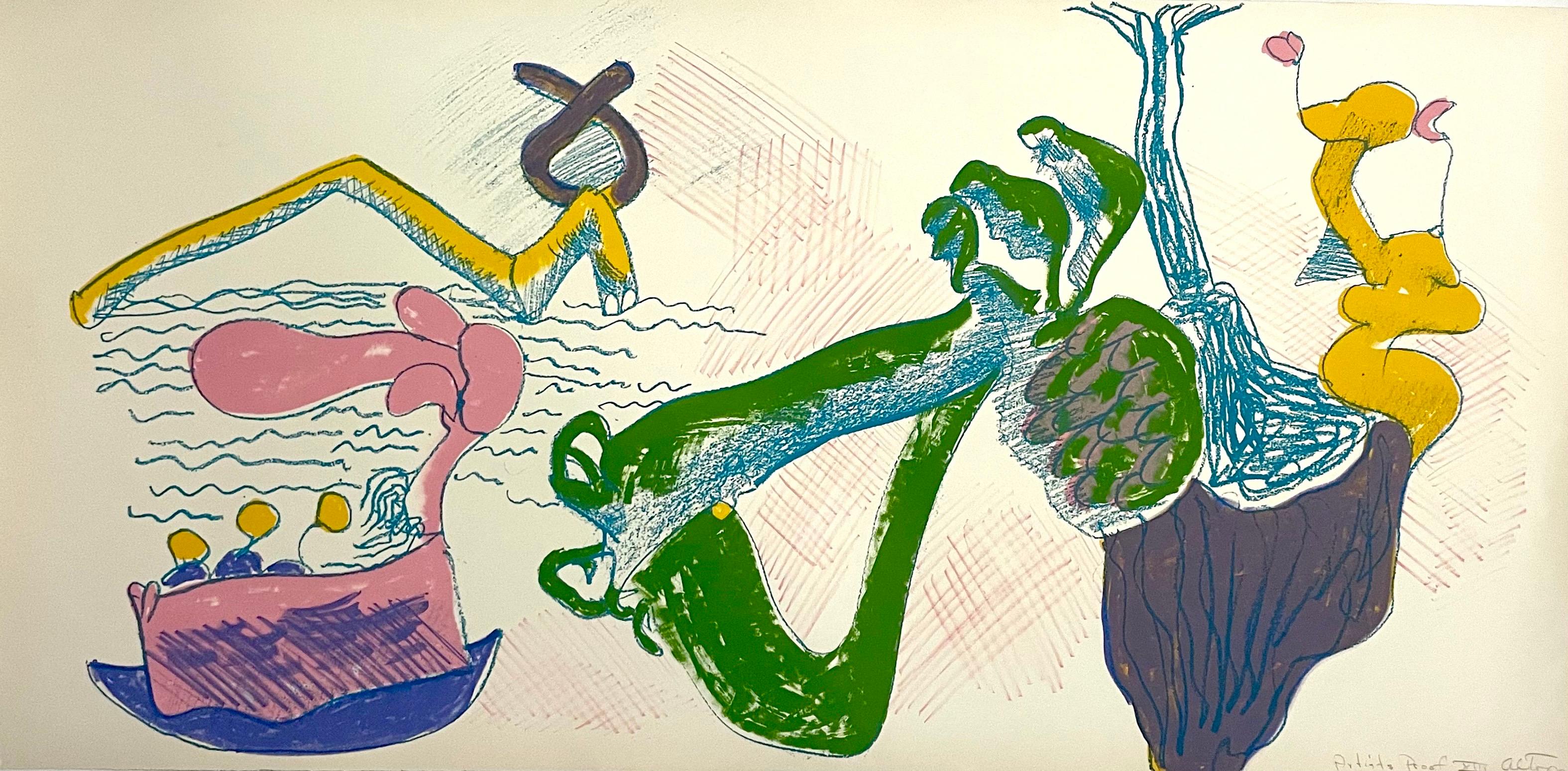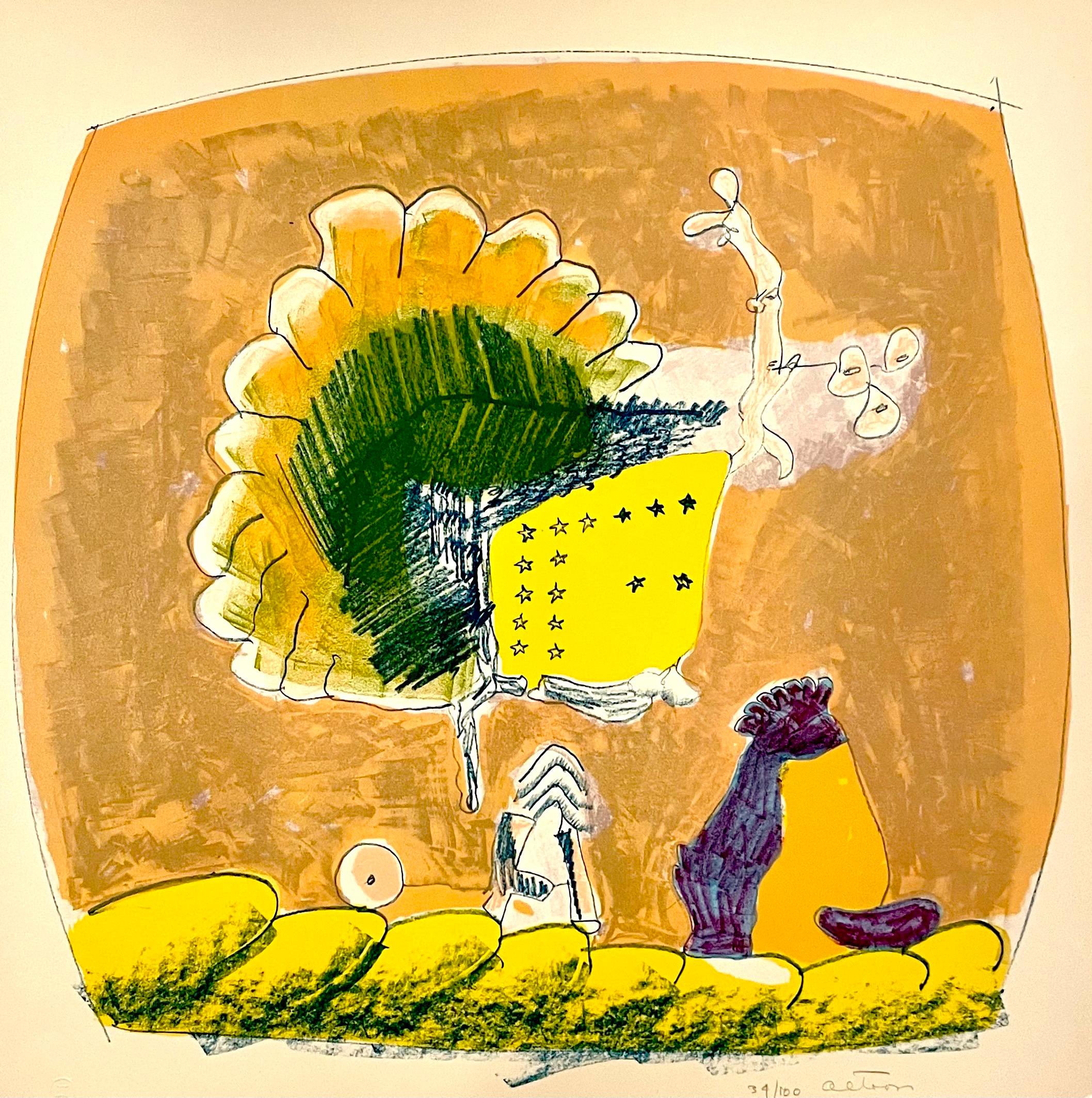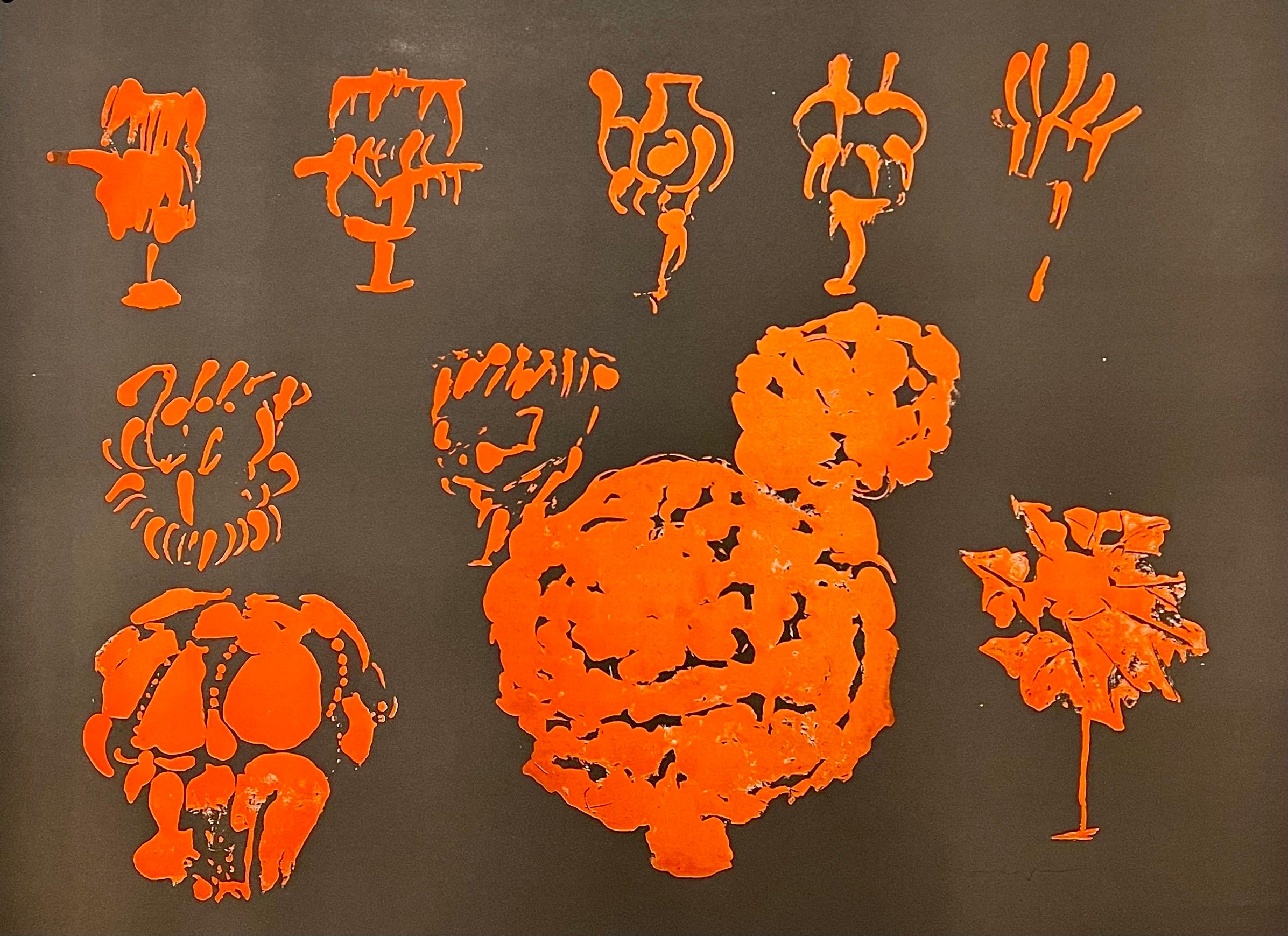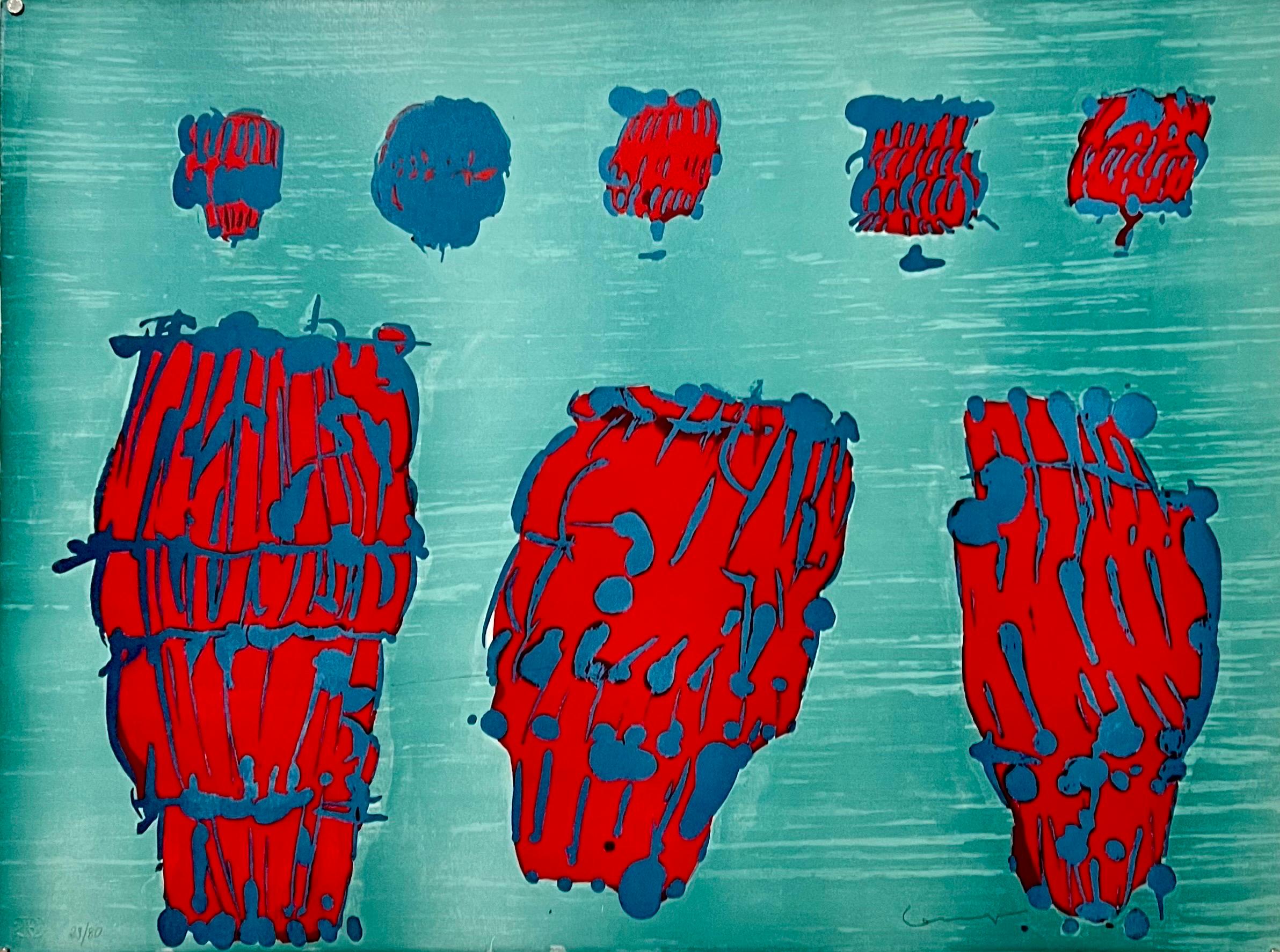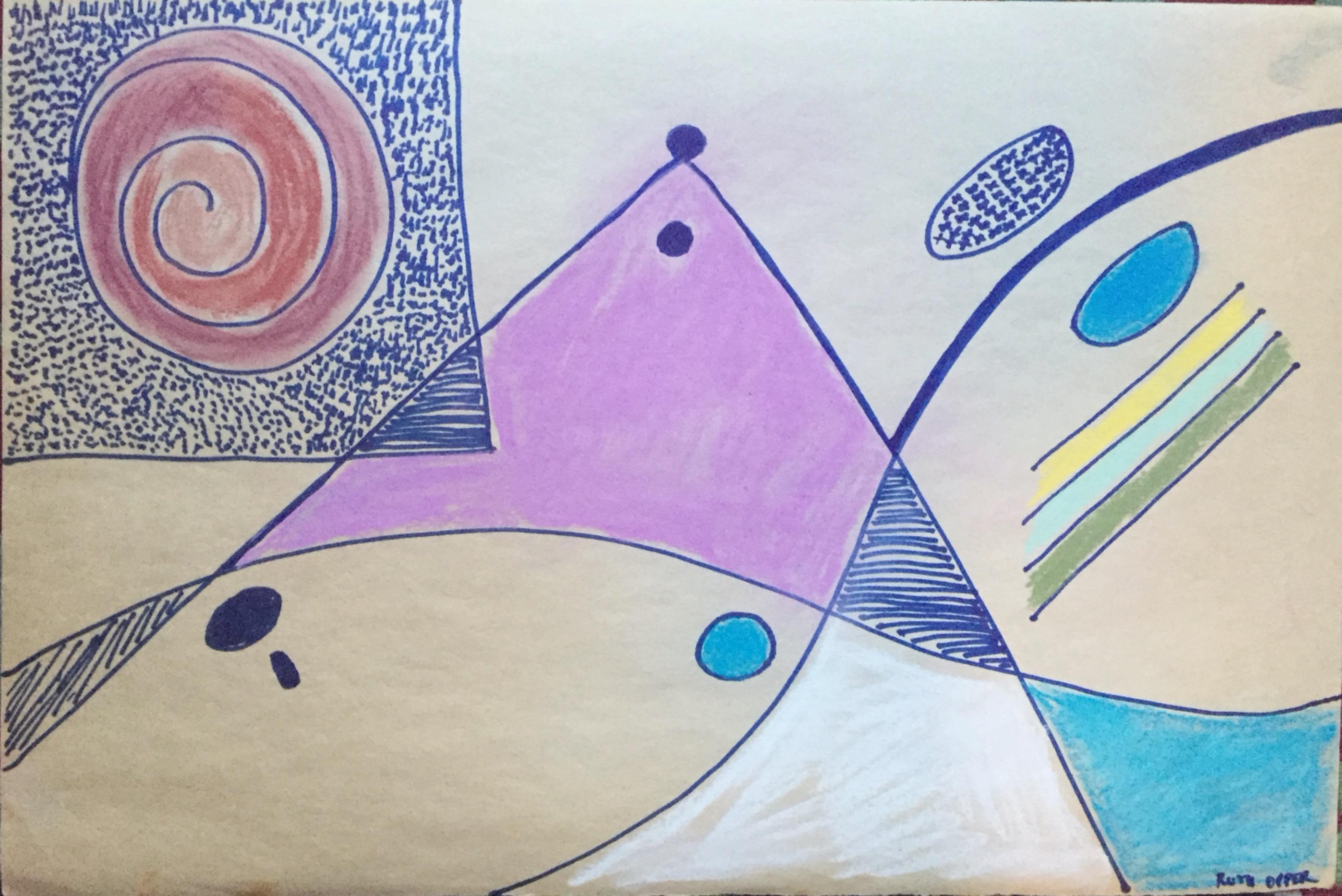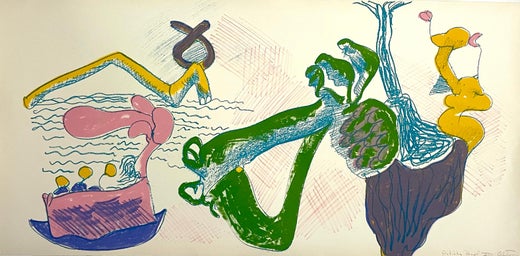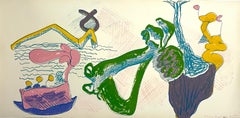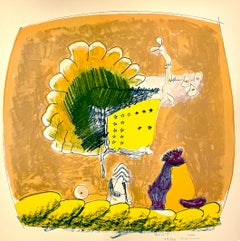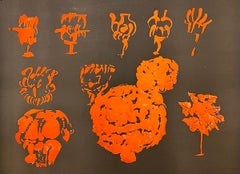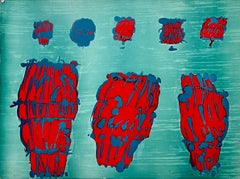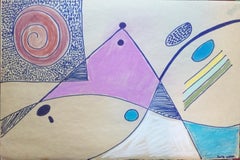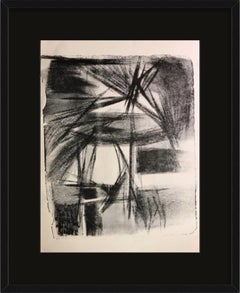Items Similar to Large 1960's California Pop Art Abstract Expressionist LA Lithograph John Altoon
Want more images or videos?
Request additional images or videos from the seller
1 of 11
John AltoonLarge 1960's California Pop Art Abstract Expressionist LA Lithograph John Altoon1966
1966
$1,375
£1,067.26
€1,215.97
CA$1,965.02
A$2,140.06
CHF 1,128.38
MX$26,029.30
NOK 14,189.32
SEK 13,308.42
DKK 9,079.99
About the Item
John Altoon (1925-1969)
UNTITLED, 1966, color lithograph, hand signed in pencil and inscribed trail proof II, sheet 29 ¾ x 41 ¼, printed by Gemini G.E.L., with their blind stamp lower rightIllustrated in Los Angeles Prints 1883-1980, LACMA, illustration #88.
John Altoon (1925 - 1969), an American artist, was born in Los Angeles to immigrant Armenian parents. From 1947–1949 he attended the Otis Art Institute, from 1947 to 1950 he also attended the Art Center College of Design in Los Angeles, and in 1950 the Chouinard Art Institute. Altoon was a prominent figure in the LA art scene in the 1950s and 1960s. Exhibitions of his work have been held at the Museum of Contemporary Art San Diego, Whitney Museum of American Art, New York, Corcoran Gallery, Washington D.C, Fine Arts Museums of San Francisco, The Baxter Museum, Pasadena, and The Los Angeles County Museum of Art (LACMA).
Altoon's work was influenced by the Abstract Expressionism Movement although he is best known for his figurative drawings of the 1960s, with as Leah Ollman describes "a vocabulary of vaguely figurative, botanical and biological forms that he pursued until his death." He was part of the "Ferus group" of artists so called for their association to the Ferus Gallery that operated in Los Angeles in 1957–1966. Some of the other artists included in this group are Edward Kienholz, Larry Bell, Robert Irwin, Billy Al Bengston. He was featured in the Cool School documentary, a film about Altoon and other Ferus Gallery artists such as Walter Hopps and Ed Kienholz, Craig Kauffman, Wallace Berman, Ed Moses, John Altoon, and Robert Irwin. many Ferus artists say John was the most fun and friendliest of all, every where everyone liked him. He could charm anyone. Altoon, during his Ferus Gallery years, did the Ocean Park series which depicted an area around Venice and Santa Monica beach towns in California. The series was 18 paintings as well some works he did on paper. It had the direct from brain to hand & brush approach he was known for: the abstracting of nature on his canvas by pushing through a spontaneous approach, freehand biomorphic in design giving us his surrealist interpretation as a direct rendering of the coastal surroundings.
Leah Ollman describes his life a 1999 article in Art in America, "With his outsized personality and reckless intensity, John Altoon loomed large in the L.A. art scene of the '50s and '60s.
Altoon was diagnosed as schizophrenic in his late 30s and suffered bouts of depression and paranoia. I
Irving Blum, partner in the Ferus Gallery, recalls: "If the gallery was closest in spirit to a single person, that person was John Altoon--dearly loved, defiant, romantic, highly ambitious--and slightly mad." Altoon's struggle with mental illness, his big, dark, robust personality and his early death from a heart attack at 44 have, even more than his art itself, come to define his legacy."
- Creator:John Altoon (1925 - 1969)
- Creation Year:1966
- Dimensions:Height: 29.75 in (75.57 cm)Width: 41.5 in (105.41 cm)
- Medium:
- Movement & Style:
- Period:
- Condition:good. possible minor toning to paper. light wear. never framed.
- Gallery Location:Surfside, FL
- Reference Number:1stDibs: LU38215994032
John Altoon (1925-1969) was an artist and commercial illustrator known for loose drawings of botanicals and natural form. His work crosses a hybrid between abstract and figurative, influenced by Abstract Impressionism. Altoon used color and line movement to connect sociopolitical messages with the viewer’s eye. A prominent member of the Ferus Gallery’s group of artists and Wallace Berman’s Semina circle, Altoon was influenced of artists like Pablo Picasso in creating raw, satirical pieces of work. Born in Los Angeles, John Altoon attended the Otis Art Institute, the Art Center College of Design, and the Chouinard Art Institute. His work has been exhibited at the Museum of Contemporary Art San Diego, the Whitney Museum of American Art, New York, and Fine Arts Museums of San Francisco.
About the Seller
4.9
Platinum Seller
Premium sellers with a 4.7+ rating and 24-hour response times
Established in 1995
1stDibs seller since 2014
1,824 sales on 1stDibs
Typical response time: 1 hour
- ShippingRetrieving quote...Shipping from: Surfside, FL
- Return Policy
Authenticity Guarantee
In the unlikely event there’s an issue with an item’s authenticity, contact us within 1 year for a full refund. DetailsMoney-Back Guarantee
If your item is not as described, is damaged in transit, or does not arrive, contact us within 7 days for a full refund. Details24-Hour Cancellation
You have a 24-hour grace period in which to reconsider your purchase, with no questions asked.Vetted Professional Sellers
Our world-class sellers must adhere to strict standards for service and quality, maintaining the integrity of our listings.Price-Match Guarantee
If you find that a seller listed the same item for a lower price elsewhere, we’ll match it.Trusted Global Delivery
Our best-in-class carrier network provides specialized shipping options worldwide, including custom delivery.More From This Seller
View All1960's California Pop Art Abstract Expressionist LA Lithograph "About Women"
Located in Surfside, FL
John Altoon (American, 1925-1969)
From the 'About Women' Series.
Color lithograph
1965/66,
Hand signed and editioned in pencil with the chop mark of Gemini G.E.L. publishers
John Altoon (1925 - 1969), an American artist, was born in Los Angeles to immigrant Armenian parents. From 1947–1949 he attended the Otis Art Institute, from 1947 to 1950 he also attended the Art Center College of Design in Los Angeles, and in 1950 the Chouinard Art Institute. Altoon was a prominent figure in the LA art scene in the 1950s and 1960s. Exhibitions of his work have been held at the Museum of Contemporary Art San Diego, Whitney Museum of American Art, New York, Corcoran Gallery, Washington D.C, Fine Arts Museums of San Francisco, The Baxter Museum, Pasadena, and The Los Angeles County Museum of Art (LACMA).
Altoon's work was influenced by the Abstract Expressionism Movement although he is best known for his figurative drawings of the 1960s, with as Leah Ollman describes "a vocabulary of vaguely figurative, botanical and biological forms that he pursued until his death." He was part of the "Ferus group" of artists so called for their association to the Ferus Gallery that operated in Los Angeles in 1957–1966. Some of the other artists included in this group are Edward Kienholz, Larry Bell, Robert Irwin, Billy Al Bengston. He was featured in the Cool School documentary, a film about Altoon and other Ferus Gallery artists such as Walter Hopps and Ed Kienholz...
Category
1960s Abstract Expressionist Abstract Prints
Materials
Lithograph
California Pop Art Abstract Expressionist LA Lithograph John Altoon About Women
Located in Surfside, FL
Hand signed and numbered
About Women
Printed by Kenneth E. Tyler; published by Gemini G.E.L.
John Altoon (1925 - 1969), an American artist, was born in Los Angeles to immigrant Arm...
Category
1960s Pop Art Abstract Prints
Materials
Lithograph
Pietro Consagra Italian Mod Abstract Expressionist Forma Art Informel Lithograph
By Pietro Consagra
Located in Surfside, FL
Pietro Consagra (Italian, 1920-2005).
Hand signed in pencil and numbered limited edition color lithograph on Magnani paper.
Embossed stamp with limited edition numbers in pencil to lower left, and having artist pencil signature to lower right.
(from a limited edition of 80 with 15 artist's proofs)
Published by Stamperia 2RC, Rome Italy and Marlborough Gallery, Rome, Italy.
Abstract Modernist work in colors, produced in the style of the Forma art movement of Postwar Italy, of which the artist was a prominent member.
Pietro Consagra (1920 – 2005) was an Italian Post war artist working in painting, printmaking and sculpture. In 1947 he was among the founding members of the Forma 1 group of artists, proponents of structured abstraction. (similar to the Art Informel and Art Brut in France and the Brutalist artists)
Consagra was born on 6 October 1920 in Mazara del Vallo, in the province of Trapani in south-western Sicily, to Luigi Consagra and Maria Lentini. From 1931 he enrolled in a trade school for sailors, studying first to become a mechanic, and later to become a captain. In 1938 he moved to Palermo, where he enrolled in the liceo artistico; despite an attack of tuberculosis, he graduated in 1941, and in the same year signed up at the Accademia di Belle Arti, where he studied sculpture under Archimede Campini. After the Invasion of Sicily and the Allied occupation of Palermo in 1943, Consagra found work as a caricaturist for the American Red Cross club of the city; he also joined the Italian Communist Party. Early in 1944, armed with a letter of introduction from an American officer, he travelled to Rome. There he came into contact with the Sicilian artist Concetto Maugeri, and through him with Renato Guttuso, who was also Sicilian and who introduced him to the intellectual life of the city and to other postwar artists such as Leoncillo Leonardi, Mario Mafai and Giulio Turcato. Consagra signed up at the Accademia di Belle Arti di Roma in September 1944 and studied sculpture there under Michele Guerrisi, but left before completing his diploma.
In 1947, with Carla Accardi, Ugo Attardi, Piero Dorazio, Mino Guerrini, Achille Perilli, Antonio Sanfilippo and Giulio Turcato, Consagra started the artist's group Forma 1, which advocated both Marxism and structured abstraction.
Steadily Consagra's work began to find an audience. Working primarily in metal, and later in marble and wood, his thin, roughly carved reliefs, began to be collected by Peggy Guggenheim and other important patrons of the arts. He showed at the Venice Biennale eleven times between 1950 and 1993, and in 1960 won the sculpture prize at the exhibition. During the 1960s he was associated with the Continuità group, an offshoot of Forma I, and in 1967 taught at the School of Arts in Minneapolis. Large commissions allowed him to begin working on a more monumental scale, and works of his were installed in the courtyard of the Foreign Ministry in Rome and in the European Parliament, Strasbourg. His work is found in the collections of The Tate Gallery, London, in Museo Cantonale d'Arte of Lugano and the Museum of Modern Art, Paris, and the National Gallery of Art in Washington, D.C..
Consagra returned to Sicily where he sculpted a number of significant works during the 1980s. With Senator Ludovico Corrao, he helped created an open-air museum in the new town of Gibellina, after the older town had been destroyed in the earthquake of 1968. Consagra designed the gates to the town's entrance, the building named "Meeting" and the gates to the cemetery, where he was later buried.
In 1952 Consagra published La necessità della scultura ("the need for sculpture"), a response to the essay La scultura lingua morta ("sculpture, a dead language"), published in 1945 by Arturo Martini. Other works include L'agguato c'è ("the snare exists", 1960), and La città frontale ("the frontal city", 1969). His autobiography, Vita Mia, was published by Feltrinelli in 1980. In 1989 a substantial retrospective exhibition of work by Consagra was shown at the Galleria Nazionale d'Arte Moderna in Rome; in 1993 a permanent exhibition of his work was installed there. In 1991 his work was shown in the Hermitage Museum in St. Petersburg. In 2002 the Galerie der Stadt Stuttgart opened a permanent exhibition of his work. He was one of ten artists invited by Giovanni Carandente, along with David Smith, Alexander Calder, Arnaldo Pomodoro, Lynn Chadwick, and Beverly Pepper, to fabricate works in Italsider factories in Italy for an outdoor exhibition, "Sculture nella città", held in Spoleto during the summer of 1962. He was included in the The 1962 International Prize for Sculpture the jury included Argan, Romero Brest and James Johnson Sweeney the former director of the Solomon R. Guggenheim Museum in New York. The participants included Louise Nevelson and John Chamberlain for the United States; Lygia Clark for Brazil; Pietro Consagra, Lucio Fontana, Nino Franchina, and Gió Pomodoro for Italy; Pablo Serrano for Spain; and Eduardo Paolozzi, William Turnbull, and Kenneth Armitage for England. Gyula Kosice, Noemí Gerstein, Julio Gero, Naum Knop...
Category
1960s Abstract Expressionist Abstract Prints
Materials
Lithograph
Pietro Consagra Italian Mod Abstract Expressionist Forma, Art Brut Lithograph
By Pietro Consagra
Located in Surfside, FL
Pietro Consagra (Italian, 1920-2005).
Hand signed in pencil and numbered limited edition color lithograph on Magnani paper.
Embossed stamp with limited edition numbers in pencil to lower left, and having artist pencil signature to lower right.
(from a limited edition of 80 with 15 artist's proofs)
Published by Stamperia 2RC, Rome Italy and Marlborough Gallery, Rome, Italy.
Abstract Modernist work in colors, produced in the style of the Forma art movement of Postwar Italy, of which the artist was a prominent member.
Pietro Consagra (1920 – 2005) was an Italian Post war artist working in painting, printmaking and sculpture. In 1947 he was among the founding members of the Forma 1 group of artists, proponents of structured abstraction. (similar to the Art Informel and Art Brut in France and the Brutalist artists)
Consagra was born on 6 October 1920 in Mazara del Vallo, in the province of Trapani in south-western Sicily, to Luigi Consagra and Maria Lentini. From 1931 he enrolled in a trade school for sailors, studying first to become a mechanic, and later to become a captain. In 1938 he moved to Palermo, where he enrolled in the liceo artistico; despite an attack of tuberculosis, he graduated in 1941, and in the same year signed up at the Accademia di Belle Arti, where he studied sculpture under Archimede Campini. After the Invasion of Sicily and the Allied occupation of Palermo in 1943, Consagra found work as a caricaturist for the American Red Cross club of the city; he also joined the Italian Communist Party. Early in 1944, armed with a letter of introduction from an American officer, he travelled to Rome. There he came into contact with the Sicilian artist Concetto Maugeri, and through him with Renato Guttuso, who was also Sicilian and who introduced him to the intellectual life of the city and to other postwar artists such as Leoncillo Leonardi, Mario Mafai and Giulio Turcato. Consagra signed up at the Accademia di Belle Arti di Roma in September 1944 and studied sculpture there under Michele Guerrisi, but left before completing his diploma.
In 1947, with Carla Accardi, Ugo Attardi, Piero Dorazio, Mino Guerrini, Achille Perilli, Antonio Sanfilippo and Giulio Turcato, Consagra started the artist's group Forma 1, which advocated both Marxism and structured abstraction.
Steadily Consagra's work began to find an audience. Working primarily in metal, and later in marble and wood, his thin, roughly carved reliefs, began to be collected by Peggy Guggenheim and other important patrons of the arts. He showed at the Venice Biennale eleven times between 1950 and 1993, and in 1960 won the sculpture prize at the exhibition. During the 1960s he was associated with the Continuità group, an offshoot of Forma I, and in 1967 taught at the School of Arts in Minneapolis. Large commissions allowed him to begin working on a more monumental scale, and works of his were installed in the courtyard of the Foreign Ministry in Rome and in the European Parliament, Strasbourg. His work is found in the collections of The Tate Gallery, London, in Museo Cantonale d'Arte of Lugano and the Museum of Modern Art, Paris, and the National Gallery of Art in Washington, D.C..
Consagra returned to Sicily where he sculpted a number of significant works during the 1980s. With Senator Ludovico Corrao, he helped created an open-air museum in the new town of Gibellina, after the older town had been destroyed in the earthquake of 1968. Consagra designed the gates to the town's entrance, the building named "Meeting" and the gates to the cemetery, where he was later buried.
In 1952 Consagra published La necessità della scultura ("the need for sculpture"), a response to the essay La scultura lingua morta ("sculpture, a dead language"), published in 1945 by Arturo Martini. Other works include L'agguato c'è ("the snare exists", 1960), and La città frontale ("the frontal city", 1969). His autobiography, Vita Mia, was published by Feltrinelli in 1980. In 1989 a substantial retrospective exhibition of work by Consagra was shown at the Galleria Nazionale d'Arte Moderna in Rome; in 1993 a permanent exhibition of his work was installed there. In 1991 his work was shown in the Hermitage Museum in St. Petersburg. In 2002 the Galerie der Stadt Stuttgart opened a permanent exhibition of his work. He was one of ten artists invited by Giovanni Carandente, along with David Smith, Alexander Calder, Arnaldo Pomodoro, Lynn Chadwick, and Beverly Pepper, to fabricate works in Italsider factories in Italy for an outdoor exhibition, "Sculture nella città", held in Spoleto during the summer of 1962. He was included in the The 1962 International Prize for Sculpture the jury included Argan, Romero Brest and James Johnson Sweeney the former director of the Solomon R. Guggenheim Museum in New York. The participants included Louise Nevelson and John Chamberlain for the United States; Lygia Clark for Brazil; Pietro Consagra, Lucio Fontana, Nino Franchina, and Gió Pomodoro for Italy; Pablo Serrano for Spain; and Eduardo Paolozzi, William Turnbull, and Kenneth Armitage for England. Gyula Kosice, Noemí Gerstein, Julio Gero, Naum Knop...
Category
1960s Abstract Expressionist Abstract Prints
Materials
Lithograph
Abstract Expressionist Drawing
By John Levee
Located in Surfside, FL
Provenance: Darthea Speyer, Paris.
backing 12 X 17 image 8.5 X 11.5
John Levee (1924 - 2017) was an American modern art abstract expressionist painter who had worked in Paris since ...
Category
1960s Abstract Expressionist Abstract Drawings and Watercolors
Materials
Ink
Mod Abstract Expressionist Modernist Lithograph Edward Avedisian Color Field Art
By Edward Avedisian
Located in Surfside, FL
Edward Avedisian (1936-2007)
Cleo, Fur Queen, 1969
Lithograph in color on Arches wove paper.
Hand signed, dated and numbered in pencil.
Edition 100
Dimensions:
22.25 inches X 30.25...
Category
1960s Abstract Expressionist Abstract Prints
Materials
Lithograph
You May Also Like
Homage to Robert Jones, Abstract Geometric Lithograph by Jay Milder
By Jay Milder
Located in Long Island City, NY
Artist: Jay Milder, American (1934 - )
Title: Homage to Robert Jones
Medium: Lithograph, signed and numbered in pencil
Edition: 275
Size: 27.5 x 39.5 in. (69.85 x 100.33 cm)
Category
1980s Abstract Expressionist Abstract Prints
Materials
Lithograph
1950s Mid Century Abstract Expressionist Drawing
Located in Arp, TX
From the estate of Jerry and Ruth Opper
Abstract Expressionism Drawing
c.1950s
Ink and Pastel Drawing
18" x 12" Unframed
Unsigned
*Custom framing available ...
Category
Mid-20th Century American Modern Abstract Drawings and Watercolors
Materials
Paper, Pastel, Ink
C.1950s Abstract Mid Century Lithograph
By Jerry Opper
Located in Arp, TX
From the estate of Jerry and Ruth Opper
Abstract Fireworks
1950's
Stone Lithograph on Paper
12.5" x 19", Unframed
Came from a portfolio of his work from his estate.
Jerry Opper (192...
Category
Mid-20th Century Abstract Abstract Prints
Materials
Stone
Abstract Composition - Lithograph by J. Mailhe - 1967
Located in Roma, IT
Abstract is an original lithograph on paper by Jean Mailhe (born1912), realized in 1967 as cover for the invitation to Mailhe's vernissage organized by "L'...
Category
1960s Abstract Abstract Prints
Materials
Lithograph
Untitled - Lithograph by Giulio Turcato - 1970s
Located in Roma, IT
Untitled is a colored lithograph realized by the contemporary artist Giulio Turcato in the 1970s.
Hand-signed in pencil on the lower right.
Edited by ...
Category
1970s Abstract Abstract Prints
Materials
Lithograph
Abstract Composition - Lithograph by Carla Accardi - 1970 ca.
By Carla Accardi
Located in Roma, IT
Limited edition of 150 pieces, hand signed and numbered.
Excellent conditions.
Category
1970s Abstract Abstract Prints
Materials
Lithograph
More Ways To Browse
Donald Judd Aquatint
Enrique Carbajal Sebastian
Essencies De La Terra
Eva Kolosvary Stupler
Faure Le
Flavin Poster
Francisco Moreno Capdevila
Frank Stella Sinjerli
Frank Stella The Whale Watch
Fred Berman
George Ennis
Gunther Gerzso
Hans Hartung On Sale
Helen Frankenthaler Lincoln Center
Helen Frankenthaler Poster
Highway Pop Art
Howard Hodgkin Poster
Howard Rose
